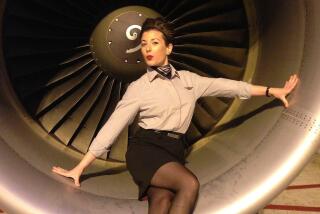A Thriller Unfolds in the Friendly Skies
- Share via
If you are a white-knuckle flier, be forewarned--Tom Casey’s “Human Error” will tell you far more than you really want to know about what happens in an airline disaster. And surely you will not want to bring his book along as a way to kill a few hours on your next flight.
Still, Casey’s account of the crash landing of a commercial airliner is hard to put down. Unlike the tantalizing sound bites that accompany the media coverage of real airplane crashes, “Human Error” allows us to see the heart-shaking moments of terror and the painstaking accident investigation that follows in vivid detail.
The inquiry, according to Casey, is both a technological detective story and a metaphysical quest, a weighing of “acceptable risk against titanic forces of nature and human error.” At stake is the career of an entirely likable airline captain named Hugo Price, a 43-year-old pilot who is exactly the kind of pro you would want in the cockpit--an Air Force veteran with 12,000 hours aloft and no “anomalies” in his training or flight records that might predict an incident of deadly pilot error.
Casey, who is a pilot for American Airlines when he is not writing novels, is the right man for the task of telling Hugo Price’s story--we are told that the author once brought off an emergency landing of a vintage aircraft in real life. No one was hurt in real life, but the crash that is the centerpiece of “Human Error” results in the death of 45 people and a crisis of conscience for the good-hearted pilot.
Casey clearly feels obliged to flesh out what is essentially a techno-thriller by burdening Hugo Price with an accumulation of emotional baggage that is supposed to show how stressed-out a pilot can be when he sits at the controls of a jetliner. Between flashbacks and flash-forwards, we are allowed to witness the crisis in his deeply troubled marriage and an unsettling, but ultimately redemptive love affair between Price and his co-pilot, Sarah McClure--”a woman of legible good looks,” as Casey put it.
Some of these narrative touches appear to be reflexive, and some are a stretch. Sarah is almost too good to be true, cool and competent both in the cockpit and in the bedroom. Price’s wife, by contrast, is a vicious harridan who verbally abuses her husband before drawing real blood: “What girl could guess that regular bloodletting was the signature of womanhood?” muses the hateful Lydia before oozing into her next sexual adventure.
“Human Error” begins to soar when Casey embarks on the quest that is the real theme of his book. What caused Flight 555 to crash--engine failure, wind shear, pilot error, or some incalculable combination of all three? And the story reaches cruising speed in the second half of the book, when Casey stops punching the fast-forward button and focuses on the investigation that will determine whether Hugo Price will ever fly again.
“Landing in a swamp is missing the point of our commitment to service,” cracks the airline executive who holds the pilot’s fate in his hands. “We can’t afford to kill our customers.”
Since “Human Error” turns out to be a kind of technological whodunit--or, perhaps more to the point, a what-done-it--I will not disclose whether Hugo Price survives the stresses and strains that are brought to bear upon him in the wake of the crash. Suffice it to say, however, that Casey brings the flight of fancy down for a three-point landing.
“Professional flying is a mystery to most people,” a crash investigator tells the troubled Price, neatly summing up the author’s approach to his tale and the essential appeal of the book itself. “Mystery stimulates the need for answers.”
More to Read
Sign up for our Book Club newsletter
Get the latest news, events and more from the Los Angeles Times Book Club, and help us get L.A. reading and talking.
You may occasionally receive promotional content from the Los Angeles Times.









